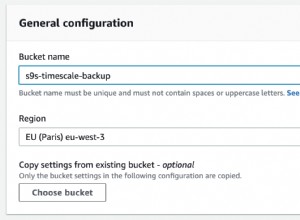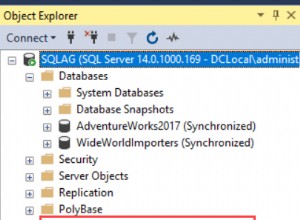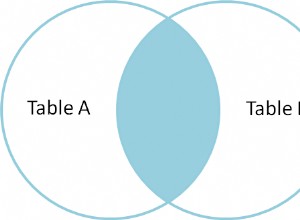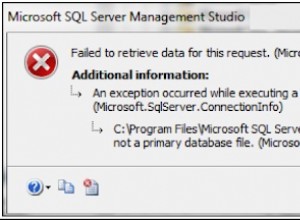J'ai trouvé que les choses que SQL Server vous donne pour faire une correspondance floue sont assez maladroites. J'ai eu vraiment de la chance avec mes propres fonctions CLR en utilisant l'algorithme de distance de Levenshtein et une certaine pondération. En utilisant cet algorithme, j'ai ensuite créé un UDF appelé GetSimilarityScore qui prend deux chaînes et renvoie un score compris entre 0,0 et 1,0. Plus la correspondance est proche de 1,0, mieux c'est. Ensuite, interrogez avec un seuil>=0,8 environ pour obtenir les correspondances les plus probables. Quelque chose comme ça :
if object_id('tempdb..#similar') is not null drop table #similar
select a.id, (
select top 1 x.id
from MyTable x
where x.id <> a.id
order by dbo.GetSimilarityScore(a.MyField, x.MyField) desc
) as MostSimilarId
into #similar
from MyTable a
select *, dbo.GetSimilarityScore(a.MyField, c.MyField)
from MyTable a
join #similar b on a.id = b.id
join MyTable c on b.MostSimilarId = c.id
Ne le faites pas avec de très grandes tables. C'est un processus lent.
Voici les UDF CLR :
''' <summary>
''' Compute the distance between two strings.
''' </summary>
''' <param name="s1">The first of the two strings.</param>
''' <param name="s2">The second of the two strings.</param>
''' <returns>The Levenshtein cost.</returns>
<Microsoft.SqlServer.Server.SqlFunction()> _
Public Shared Function ComputeLevenstheinDistance(ByVal string1 As SqlString, ByVal string2 As SqlString) As SqlInt32
If string1.IsNull OrElse string2.IsNull Then Return SqlInt32.Null
Dim s1 As String = string1.Value
Dim s2 As String = string2.Value
Dim n As Integer = s1.Length
Dim m As Integer = s2.Length
Dim d As Integer(,) = New Integer(n, m) {}
' Step 1
If n = 0 Then Return m
If m = 0 Then Return n
' Step 2
For i As Integer = 0 To n
d(i, 0) = i
Next
For j As Integer = 0 To m
d(0, j) = j
Next
' Step 3
For i As Integer = 1 To n
'Step 4
For j As Integer = 1 To m
' Step 5
Dim cost As Integer = If((s2(j - 1) = s1(i - 1)), 0, 1)
' Step 6
d(i, j) = Math.Min(Math.Min(d(i - 1, j) + 1, d(i, j - 1) + 1), d(i - 1, j - 1) + cost)
Next
Next
' Step 7
Return d(n, m)
End Function
''' <summary>
''' Returns a score between 0.0-1.0 indicating how closely two strings match. 1.0 is a 100%
''' T-SQL equality match, and the score goes down from there towards 0.0 for less similar strings.
''' </summary>
<Microsoft.SqlServer.Server.SqlFunction()> _
Public Shared Function GetSimilarityScore(string1 As SqlString, string2 As SqlString) As SqlDouble
If string1.IsNull OrElse string2.IsNull Then Return SqlInt32.Null
Dim s1 As String = string1.Value.ToUpper().TrimEnd(" "c)
Dim s2 As String = string2.Value.ToUpper().TrimEnd(" "c)
If s1 = s2 Then Return 1.0F ' At this point, T-SQL would consider them the same, so I will too
Dim flatLevScore As Double = InternalGetSimilarityScore(s1, s2)
Dim letterS1 As String = GetLetterSimilarityString(s1)
Dim letterS2 As String = GetLetterSimilarityString(s2)
Dim letterScore As Double = InternalGetSimilarityScore(letterS1, letterS2)
'Dim wordS1 As String = GetWordSimilarityString(s1)
'Dim wordS2 As String = GetWordSimilarityString(s2)
'Dim wordScore As Double = InternalGetSimilarityScore(wordS1, wordS2)
If flatLevScore = 1.0F AndAlso letterScore = 1.0F Then Return 1.0F
If flatLevScore = 0.0F AndAlso letterScore = 0.0F Then Return 0.0F
' Return weighted result
Return (flatLevScore * 0.2F) + (letterScore * 0.8F)
End Function
Private Shared Function InternalGetSimilarityScore(s1 As String, s2 As String) As Double
Dim dist As SqlInt32 = ComputeLevenstheinDistance(s1, s2)
Dim maxLen As Integer = If(s1.Length > s2.Length, s1.Length, s2.Length)
If maxLen = 0 Then Return 1.0F
Return 1.0F - Convert.ToDouble(dist.Value) / Convert.ToDouble(maxLen)
End Function
''' <summary>
''' Sorts all the alpha numeric characters in the string in alphabetical order
''' and removes everything else.
''' </summary>
Private Shared Function GetLetterSimilarityString(s1 As String) As String
Dim allChars = If(s1, "").ToUpper().ToCharArray()
Array.Sort(allChars)
Dim result As New StringBuilder()
For Each ch As Char In allChars
If Char.IsLetterOrDigit(ch) Then
result.Append(ch)
End If
Next
Return result.ToString()
End Function
''' <summary>
''' Removes all non-alpha numeric characters and then sorts
''' the words in alphabetical order.
''' </summary>
Private Shared Function GetWordSimilarityString(s1 As String) As String
Dim words As New List(Of String)()
Dim curWord As StringBuilder = Nothing
For Each ch As Char In If(s1, "").ToUpper()
If Char.IsLetterOrDigit(ch) Then
If curWord Is Nothing Then
curWord = New StringBuilder()
End If
curWord.Append(ch)
Else
If curWord IsNot Nothing Then
words.Add(curWord.ToString())
curWord = Nothing
End If
End If
Next
If curWord IsNot Nothing Then
words.Add(curWord.ToString())
End If
words.Sort(StringComparer.OrdinalIgnoreCase)
Return String.Join(" ", words.ToArray())
End Function




